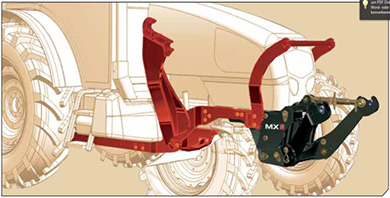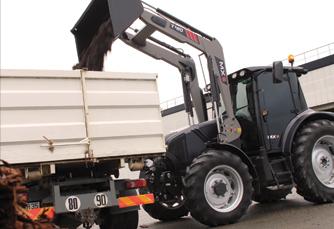Formerly called MAILLEUX, MX is a family company that was founded in France in 1951. The company specializes in the design, manufacturing and marketing of handling equipment for farm tractors. MX can fit over 6000 tractor models, which makes MX a worldwide leader in its market.
Among other things, MX possesses expertise in designing brackets (to fit loading arms) for all farm tractors on the market, as well as in developing steering systems for its loaders.
The problem
Tractor manufacturers rarely leak information on their products, and it proves even more difficult, if not impossible, to obtain 3D models. However, these models are essential in order to develop and manufacture equipment parts like MX does with loading arms. As such, MX must take 3D measurements of all tractors for which it wishes to design and build the adapted equipment. Recorded in a factory, these measurements are needed in order to obtain a 3D model for each tractor.
Up until recently, MX used 3D measurement arms (such as Romer and Faro) to measure, scan and reconstruct a complete 3D tractor model. The process made this solution viable, but the labor costs were extremely high, since an entire week was required to complete the task. Furthermore, the measurement arms had to be moved many times during the measurement process. Every time the part was repositioned, the device had to be calibrated again in a stable environment, and then, reinstalled.
In an attempt to shorten the measurement time and curb the related costs, the Technical Service started looking for an alternative solution, one that could be faster as well as more flexible, and which measurements would be precise and reliable, regardless of the measurement environment conditions.
Eureka!

Technological Integration into the Workflow
In the fall of 2012, the company purchased a Creaform’s scanning and probing system, including a HandyPROBE portable CMM, a MetraSCAN 3D optical CMM scanner, a C-Track 780 dual-camera sensor, along with the Geomagic Solutions post-treatment software from 3D Systems. Nowadays, MX uses Creaform technologies to digitize its tractors: scanning all the areas needed to design the adapted structures, including the bracket mounting points and their environment (tractor cabs, exhaust pipe, gas tank, battery box, filters, pipes, radiator, engine and motor belt pulley). The surfaces are processed, cut, and cleaned with Geomagic Solutions, then exported to CAD in .stl format.
Furthermore, integrating these portable 3D measurement technologies from Creaform enabled MX to set up a flexible measurement system that can be used by 6 different resources at the design office.
Measurement Speed = Faster Work Volume
Mr. Emmanuel Renoux, R&D director at MX, explains how the Creaform technologies helped the company. “This system enabled us to shorten our measurement time by more than half. Because of that time-saving, we can measure a greater number of tractors, which in turn makes it possible for us to offer a wider choice for our customers, and have a more competitive time-to-market. Our goal is to go from about 50 projects a year to roughly 100 when we “reach full speed,” so to speak. This new equipment additionally makes our work quicker and easier when we need to take measurements externally, whether in France or abroad”.
“Had we not invested in this equipment, we would not have been able to keep up with the pace, since new tractors keep arriving on the market at an increasingly fast speed, as manufacturers offer more and more different variations in order to better answer their customers’ (farmers) needs. Since we are now better equipped to measure these tractors, we even reinforced our design teams in order to optimize and benefit from all this data,” added Mr. Lenoux.





